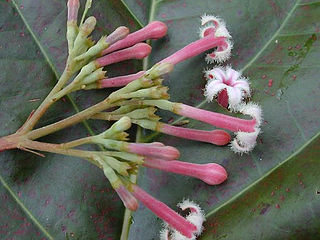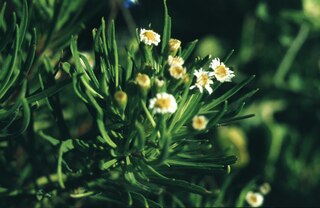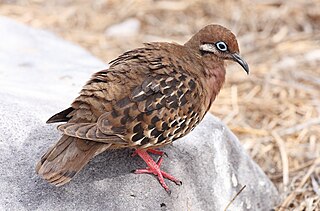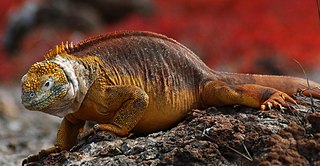
Linum (flax) is a genus of approximately 200 species in the flowering plant family Linaceae. They are native to temperate and subtropical regions of the world. The genus includes the common flax, the bast fibre of which is used to produce linen and the seeds to produce linseed oil.

The Galápagos petrel is one of the six endemic seabirds of the Galápagos. Its scientific name derives from Ancient Greek: Pterodroma originates from pteron and dromos, meaning "wing" and "runner", and phaeopygia comes from phaios and pugios, meaning "dusky" and "rump". Members of Pterodroma genus are also called the gadfly petrels because their erratic twisting and turning in flight resemble that of gadflies.

The lava gull, also known as the dusky gull, is a medium-sized gull and a member of the "hooded gull" group. It is most closely related to the Laughing gull and Franklin's gull and is the rarest gull in the world. It is endemic to the Galapagos Islands.

Cedrela odorata is a commercially important species of tree in the chinaberry family, Meliaceae, commonly known as Spanish cedar or Cuban cedar or cedro in Spanish.

Nagykovácsi is a small town in the Pilisvörösvári kistérség district of Hungary situated some 15 km (9 mi) north-west of the centre of Budapest, in a valley, at an altitude of 340 metres. It is located next to the second district of Budapest. According to the 2011 census, its population was given as 7095, though this figure does not include the many people who own a property there as a second residence. The town is known for its scenic setting in surrounding hills and forests, and some of the nearby forests have been designated conservation areas—Budai Tájvédelmi Körzet —in order to protect several rare species of flora growing there. Its location has contributed to the town's development in recent years. The American International School of Budapest chose Nagykovácsi as the site for its new campus in 2000.

An IUCN Red List Critically Endangered (CR) species is one that has been categorized by the International Union for Conservation of Nature as facing an extremely high risk of extinction in the wild. As of 2021, of the 120,372 species currently tracked by the IUCN, there are 6,811 species that are considered to be Critically Endangered.

Cinchona pubescens, also known as red cinchona and quina (Quechua), is native to Central and South America. It is known as a medicinal plant for its bark's high quinine content- and has similar uses to Cinchona officinalis in the production of quinine, most famously used for treatment of malaria.

A species that is extinct in the wild (EW) is one that has been categorized by the International Union for Conservation of Nature as known only by living members kept in captivity or as a naturalized population outside its historic range due to massive habitat loss.
Nesoryzomys swarthi, also known as the Santiago nesoryzomys or Santiago Galápagos mouse, is a species of rodent in the genus Nesoryzomys of family Cricetidae. It is found only on Santiago in the Galápagos Islands. Its natural habitat is subtropical or tropical dry shrubland.

The Galápagos rice rat, also known as the Galápagos oryzomys, is a species of rodent that is endemic to the Galápagos Islands.

Scalesia affinis Hook. is a species of flowering plant in the family Asteraceae. It is endemic to the Galápagos Islands, Ecuador.

The Galápagos dove is a species of bird in the family Columbidae. It is endemic to the Galápagos, off Ecuador. It is fairly common and is found in a wide range of open and semi-open habitats, especially in the arid lowlands of the archipelago.

The Galápagos mockingbird is a species of bird in the family Mimidae. It is endemic to the Galápagos Islands, Ecuador.

The Galápagos land iguana is a species of lizard in the family Iguanidae. It is one of three species of the genus Conolophus. It is endemic to the Galápagos Islands (Ecuador), in the dry lowlands of Fernandina, Isabela, Santa Cruz, North Seymour, Baltra, and South Plaza Islands.

An endling is the last known individual of a species or subspecies. Once the endling dies, the species becomes extinct. The word was coined in correspondence in the scientific journal Nature. Alternative names put forth for the last individual of its kind include ender and terminarch.

Allium cratericola is a species of wild onion known by the common name Cascade onion. It is endemic to California, where is an uncommon member of the flora in several of the state's mountain ranges, including the northern and southern California Coast Ranges, the western Transverse Ranges, Klamath Mountains, and the Sierra Nevada foothills. Its range covers much of the state, from Riverside County to Siskiyou County.

Conolophus marthae, the Galápagos pink land iguana, is a species of lizard of the family Iguanidae. This critically endangered iguana is native only to the Wolf Volcano in northern Isabela Island of the Galápagos (Ecuador). It has a pink body with some dark stripes, prompting some to call it the pink iguana or the Galápagos rosy iguana. The species was first discovered in 1986 and was identified as a separate species, distinct from the Galápagos land iguana, early in 2009. This species is the only example of ancient diversification in the genus Conolophus and is one of the oldest events of divergence ever recorded in the Galápagos.

The Galápagos penguin is a penguin endemic to the Galápagos Islands, Ecuador. It is the only penguin found north of the equator. Most inhabit Fernandina Island and the west coast of Isabela Island. The cool waters of the Humboldt and Cromwell Currents allow it to survive despite the tropical latitude. The Galápagos penguin is one of the banded penguins, the other species of which live mostly on the coasts of Africa and mainland South America. It is one of the smallest species of penguin in the world. Because of their warm environment, Galápagos penguins have developed techniques to stay cool. The feathers on their back, flippers, and head are black, and they have a white belly and a stripe looping from their eyes down to their neck and chin. Each penguin keeps only one mate, and breeds year-round. Their nests are typically in caves and crevices as protection against predators and the harsh environment. The Galápagos penguin has a lifespan of about 15 to 20 years, but due to predation, life expectancy in the wild could be significantly reduced.
Froelichia juncea is a plant species native to the Galápagos Islands of Ecuador. There are two subspecies of F. juncea: F. juncea subsp. juncea and F. juncea subsp. alata. F. juncea subsp. alata was first described by Thomas J. Howell.

Cerro Pajas is an inactive volcano located in the south of Floreana Island in the Galápagos Islands, Ecuador. It is the highest peak on Floreana, with a maximum elevation of 640 meters above sea level.

















